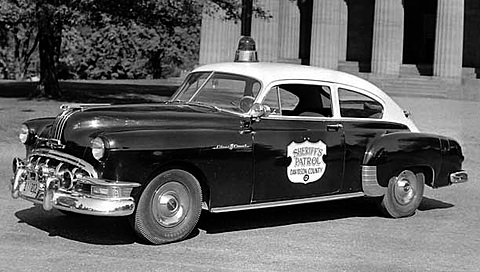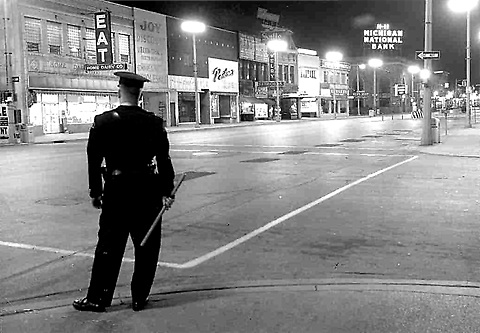SUBJECT: HO'OKAHI KAUAI
SOURCE: JUAN WILSON juanwilson@mac.com
POSTED: 7 JUNE 2008 - 9:00am HST
TGI #31: KPD Policy: Part Two - Patrolling

image above: A 1950 Pontiac patrol cruiser with gumball flasher and sherif's meddalion
Normally this column scheduled to appear every other Saturday in the Forum of Kauai Garden Island News editorial page. These TGI articles are derived from IslandBreath.org stories. The TGI final printed version may vary from its source, as TGI retains the right to correct and edit the submitted articles. The exclusive use, and copyright to the published version is held by TGI owner, Kauai Publishing. by Juan Wilson on 7 June 2008 Revision 3.1 080606 This article details aspects of the mission of the Kauai Police Department discussed in the May 24th Island Breath column. The intent is to examine existing and alternative methods of police patrol. Police Car Patrols In the 1970s the Kansas City Preventive Patrol Experiment was scientific and thorough (see www.policefoundation.org). What it concluded was surprising, suggesting that routine preventive patrol in marked police cars has little value in preventing crime or making citizens feel safe. That is a startling result and has been underreported. Almost universally, the use of the radio-patrolcar is considered the backbone of police work. Billions of dollars are spent each year to have police officers patrolling the streets in marked police cars in order to deter people committing crimes. In the end, these patrols mostly focus on fining the public for infractions of driving rules. Harvard-trained sociologist Peter Moskos became a policeman in Baltimore’s roughest neighborhood - the Eastern District. He documented his experience in his book "Cop in the Hood". Moskos says; "The Kansas City Preventative Patrol Experiment showed that cars don’t matter. Cops only need to be in cars to backup other police officers. Almost everything else could be done by foot and bike. And yet the Kansas City study changed nothing... Culturally, police like patrol cruisers and it’s almost impossible to get police out of cars." If primarily relying on patrol cars is an ineffective way to prevent crime we might be doing something fundamentally wrong. Moreover, the standard high-speed police cruiser may be an inappropriate vehicle for patrolling Kauai. As far as high-speed pursuit goes; the FBI law Enforcement Bulletin (July 2002) indicates that: "Police pursuits are dangerous. Available data indicate that the number of pursuits continues to increase, as well as the number of pursuit-related injuries and deaths. A traffic accident constitutes the most common terminating event in a pursuit." Police Chief Magazine reports that Hillsboro, Oregon (population 79,000) has a good police pusuit policy that allows officers to abandon chases without consulting their superiors. "In two recent cases the decision to terminate potentially dangerous pursuits was made by the original officer as soon as the officer was aware that the suspect was going to flee. In both cases, the suspect quickly abandoned his dangerous driving and dumped the vehicle. In both cases, Hillsboro officers were able to take the suspect into custody swiftly." What is the reason for a high-speed chase on a small isolated island? In the vast majority of cases, is there anyplace for the "bad guy" to go? We need to know if a few economic all-wheel-drive five-door fuel-efficient compacts might better serve our community.
|
The Garden Island News Column Menu Listing of all "Island Breath" articles submitted to TGI
15 May 2008 - 8:00pm HST

TGI Article #30: Kauai Police Mission Under Chief Darryl Perry there is a chance for a new vision
18 June 2008 - 9:00am HST

TGI Article #32: Kauai World - "Your Fired!" It seems that two articles about the Kauai Police are too much
